Not too many bushes are as sought after as hardy azaleas, which bring many large and brightly colored flowers to your yard first thing in the spring. If you know that an azalea shrub is a must-have for your garden, you might be struggling to figure out which perennials and annuals are best for growing nearby. There are quite a few ornamental ferns, trees, bushes, and flowers that share the same needs as these rhododendron species do. They prefer shade, plenty of consistent watering, and well-drained soil amended with organic matter. Or, if they dont, they can quickly adapt to survive in the conditions that azaleas require.
Some companions for hardy azaleas, such as sourwood trees and spicebushes, come with more benefits like attracting additional pollinators. Others, including sweet pepper bushes, bloom or change their foliage color during seasons where rhododendrons arent in bloom, helping you to maintain garden color for as long as possible. Depending on the advantages youre trying to reap when companion planting with azaleas, one or more of the many plant options below will be a good fit for your next garden design.
Witch hazel trees (Hamamelis spp.) are well-suited to growing near azalea shrubs due to their relatively short growth habit, soil preferences, and root system thats unlikely to interfere with that of the rhododendron species. While your azaleas steal the show in the spring and summer, your witch hazel tree will become very ornamental in the winter and fall when its leaves change color.
Daffodils (Narcissus pseudonarcissus) and azaleas are a great match. The two spring-blooming plants complement each other nicely in the garden, as the shrub offers daffodils some shade, and the flowers act as a living mulch above the azaleas roots. Consider choosing varieties of the two species with flowers in similar shades for a bright display of yellow, pink, white, or orange blooms.
Corsican hellebore (Helleborus argutifolius) is known for its pale green leaves and flowers that are often used in flower arrangements or grown ornamentally in the garden. The plant, which is also grown from a bulb, thrives alongside rhododendron species that enjoy a bit of shade and moist soil. In addition to companion planting with hardy azaleas, Corsican hellebore may also be planted beneath roses, hydrangeas, and some deciduous trees.
Ostrich ferns (Matteuccia struthiopteris) favor moist areas of the garden where they grow in the shade next to a pond or other water feature. Unlike some other ferns we cover in this collection, the ostrich fern grows large quickly and should be planted further away from your azalea bushes, so it can spread out without competing with the flowering bush. At maturity, the two plants complement each others foliage.
The maidenhair fern (Adiantum pedatum) is a well-loved indoor and outdoor plant that is easy to care for. When planted in well-draining, but evenly moist soil, with plenty of shade, the fern sends out bright green fronds covered in small leaves. Grown as an understory plant for an azalea bush, the maidenhair fern will reward you with some incredible foliage that lasts most of, or all, year depending on your climate.
Though lots of gardeners suggest growing barberry plants as companions to azaleas, few specify that the Korean barberry plant (Berberis koreana) is among the best species to pick. Compared to other barberry bushes, this one offers wonderful foliage colors in the fall as well as edible berries around the same time. Additionally, Korean barberries are spring-blooming plants that produce yellow blossoms at the same time your azaleas are flowering.
Japanese-painted ferns (Athyrium niponicum var. pictum) are known for their long fronds and colorful foliage that ranges from a silvery-green to a deep red color. The tropical-looking plant grows well in shaded locations that offer rich and moist, but well-draining, soil. Like other ferns in this collection, Japanese-painted ferns look best planted beneath a larger azalea bush.
Azaleas are stunning shrubs that bloom in spring with gorgeous clusters of flowers in shades of pink red, purple white and orange. Their bright blossoms can really light up your garden.
But azaleas on their own may leave you with a bare-looking yard the rest of the year when they aren’t in bloom. The right companion plants in front of azaleas can provide interest before, during and after azalea blooming season.
When choosing plants for in front of azaleas opt for low-growing plants that won’t block the view of azalea blooms. Evergreens like boxwoods or junipers make nice foundation plants. Bulbs and perennials can provide early spring and summer color. You can also use containers planted with annuals that you change out each year.
Here are the top 6 options for plants to put in front of azaleas:
1. Boxwood Shrubs
Boxwoods are classic foundation shrubs with neat, rounded shapes that complement the mounded form of azaleas. Their evergreen foliage looks tidy all year long. Boxwoods thrive in the same conditions azaleas require – well-drained, acidic soil and partial shade.
Shorter boxwood varieties like Green Velvet and Green Gem work well in front of azaleas. They typically grow 2-3 feet tall and wide. Larger boxwood varieties can be kept pruned to a lower height.
2. Junipers
Junipers offer soft evergreen texture, There are low growing juniper varieties that make excellent companion plants for azaleas
Blue Rug Juniper is a popular choice, growing just 4-6 inches tall. Green Creeping Juniper is another good option at 1-2 feet tall. Both spread 3-5 feet wide.
Junipers are adaptable to various soil types and lighting. They provide year-round greenery and a contrasting look next to azaleas.
3. Bulbs
Early spring blooming bulbs planted in drifts in front of azaleas can provide a burst of cheery color before azalea blossoms emerge. Plant them in the fall so they have time to establish roots before blooming.
Some top options include:
- Crocuses – Grow 3-4 inches tall. Come in purple, yellow, white.
- Hyacinths – Grow 6-8 inches tall. Available in pink, purple, white, blue.
- Daffodils – Grow 1-2 feet tall. Blooms are generally yellow.
- Tulips – Grow 1-2 feet tall. Many color options.
Mix different bulb varieties together for a colorful spring display. You can also scatter bulbs throughout azalea beds and borders.
4. Astilbe
Astilbe are perennial plants that produce feathery plumes of flowers in summer after azalea blooms have faded. They grow 1-3 feet tall, with a mounded form that complements azaleas.
Astilbe thrive in the same conditions azaleas require – moist soil and partial shade. They come in shades of white, pink, red and purple. Excellent varieties include Bridal Veil, Color Flash and Deutscheland.
5. Ferns
Ferns are perfect companion plants to grow in front of azaleas, offering lush green fronds all season long. Their arching leaves contrast beautifully with rounded azalea bushes.
Many fern varieties do well in partial shade and moist, acidic soil. Choices like Japanese painted fern, lady fern and autumn fern grow 1-3 feet tall. For smaller spaces, try tassel ferns which reach just 6-12 inches.
6. Annuals
For an easy way to change up your azalea bed each year, plant a rotating selection of annuals in front. Focus on low-growing annuals under 1 foot tall.
Great options include:
- Begonias – Grow 6-12 inches tall. Available in white, pink, red, orange blooms.
- Coleus – Grown for colorful foliage. Generally under 1 foot tall.
- Impatiens – Grow 8-24 inches tall. Blooms in a range of bright colors.
- Sweet Alyssum – Grows just 4-6 inches tall. Clusters of tiny white or purple flowers.
Use containers like pots, window boxes or hanging baskets planted with annuals to flank azaleas planted in the ground. Switch out annuals each year for fresh colors.
Key Tips for Planting in Front of Azaleas
When selecting companion plants for in front of azaleas, keep these tips in mind:
- Choose plants under 3 feet tall so they don’t hide azalea blooms
- Look for plants with different bloom times than azaleas
- Favor compact, low maintenance plants
- Consider evergreens for year-round structure
- Opt for plants suited to partial shade if azaleas are in shade
- Pick plants that prefer moist, acidic soil
- Add mulch to help soil retain moisture
Provide the Right Conditions
Azaleas need specific growing requirements to thrive. When planting companions in front, make sure to provide:
-
Well-drained soil – Wet feet will cause azalea roots to rot. Incorporate organic material like compost.
-
Acidic soil – Azaleas require a soil pH between 4.5-6.0. Use an acidic fertilizer.
-
Even moisture – Water regularly, especially during dry periods. Mulch to conserve moisture.
-
Partial shade – Dappled sunlight or morning sun is ideal. Hot afternoon sun can burn leaves.
Designing With Azaleas
Azaleas make excellent foundation shrubs, border plantings and mass plantings. Here are some tips for beautifully incorporating azaleas into your landscape design:
-
Use azaleas as foundation plants flanking entries, walkways and the house. Plant lower companion plants in front.
-
Plant in borders along fences or edges. Allow at least 2-3 feet between azaleas for future growth.
-
Plant en masse for bold color impact. Use at least 3-5 together.
-
Mix azalea varieties with different bloom times to extend color. Encore azaleas bloom in spring, summer and fall.
-
Use deciduous azaleas like native azaleas for naturalistic designs or informal hedges.
The right companion plants in front of azaleas can highlight their spectacular spring blooms while providing year-round curb appeal and landscape structure. Try boxwoods, junipers, bulbs, perennials or annuals for an elegant and coordinated design that looks great in all seasons.

Sweet pepper bush
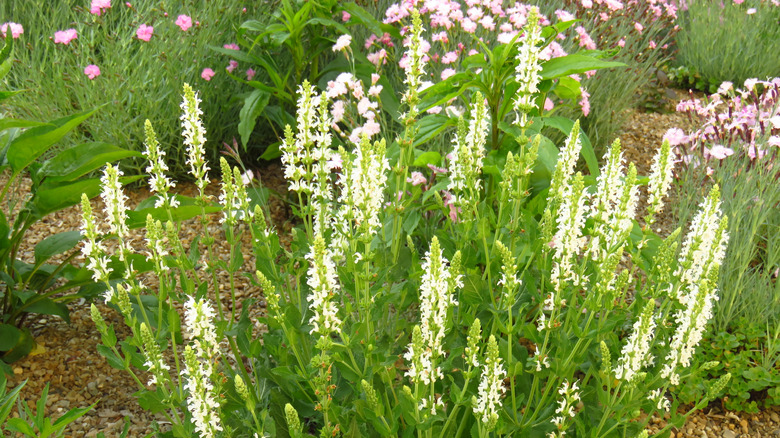
If you are trying to keep your garden colorful for as long as possible, consider planting fall or summer-blooming plants, such as sweet pepper bush (Clethra alnifolia), with your azaleas. When your rhododendrons finish blooming after three weeks in the early or mid-spring, a plant like this can swoop in and pick up right where the other flowers left off so your garden stays colorful throughout the year.
Bloom Season: Summer
USDA Growing Zone: 4 to 9
Growing Conditions: Full sun to full shade
Soil Type: Moist and well-draining
Size: 3 to 8 feet tall
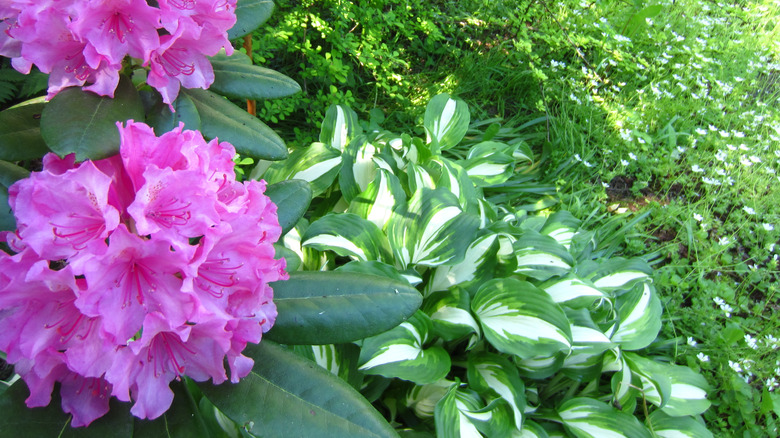
Hostas (Hosta plantaginea) are frequently planted beneath, or as a neighbor to, hardy azaleas. Their wide, fleshy foliage perfectly complements the flowering shrubs small green leaves and large blooms that appear to cluster together on the plants many stems. These two, which share similar growing requirements, youll find are simple to grow together as the care for one is just the same as the other.
Bloom Season: Mid-summer
USDA Growing Zone: 3 to 9
Growing Conditions: Partial shade
Soil Type: Moist, organic, and well-draining
Size: 2 inches to 3 feet tall and 4 inches to 5 feet wide
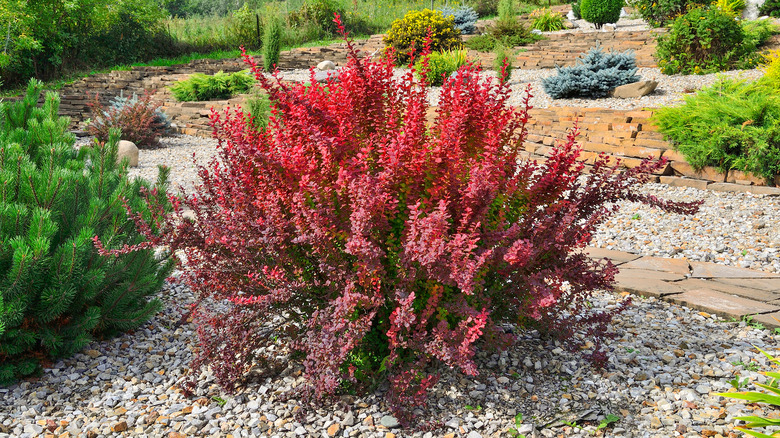
The Japanese barberry shrub (Berberis thunbergii) doesnt share all the same interests as rhododendron bushes, but it is adaptable enough to be grown alongside these prolific bloomers if you want to see these two planted next to each other. Japanese barberry shrubs look amazing next to azaleas, particularly in the fall, when they will steal the show with their color-changing leaves.
Bloom Season: Spring
USDA Growing Zone: 4 to 8
Growing Conditions: Full sun
Soil Type: Well-draining
Size: 3 to 6 feet tall and 4 to 7 feet wide
Red vein enkianthus
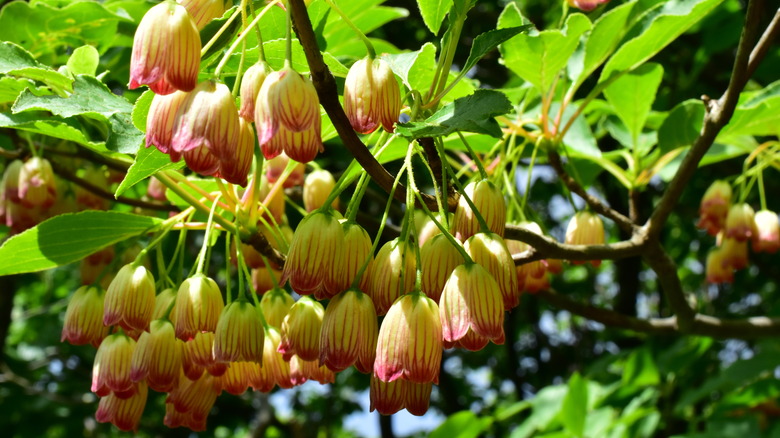
A member of the blueberry family, red vein enkianthus (Enkianthus campanulatus) can act as a companion to an azalea species. Due to its tall habit, it can cast shade on the flowering bush, which needs protection from the hot and drying sun. The small tree is deciduous, so it will lose its canopy of foliage as winter approaches, but not before it shows off its gorgeous color-changing leaves.
Bloom Season: Spring
USDA Growing Zone: 4 to 7
Growing Conditions: Full sun to partial shade
Soil Type: Moist, rich, and well-draining
Size: 6 to 16 feet tall
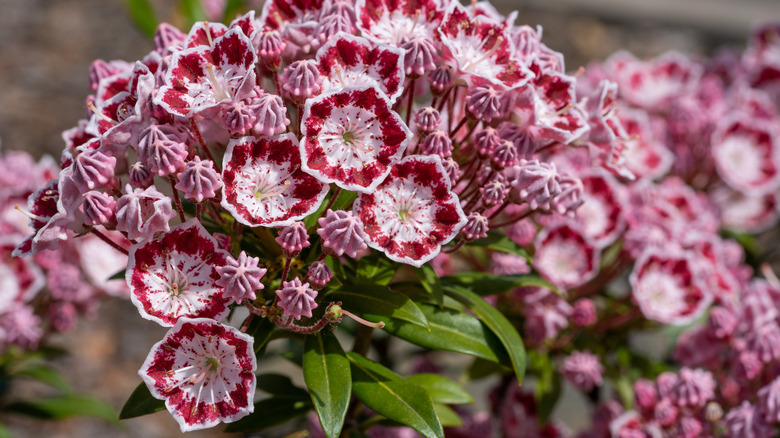
Mountain laurel (Kalmia latifolia) is hardy azaleas bestie. The medium-sized bush produces red, white, and pink flowers among bright green and glossy leaves. Partnered with the azalea bushs various blooms and darker green leaves, the two heighten each others visual interest. Both can be planted as foundation bushes along the front of your home to welcome guests and increase your houses curb appeal.
Bloom Season: Spring and summer
USDA Growing Zone: 4 to 9
Growing Conditions: Full sun to full shade
Soil Type: Rich and well-draining
Size: 4 to 15 feet tall and 4 to 8 feet wide
How to Plant Encore® Azaleas
FAQ
What plant looks good next to azaleas?
Most ferns, hostas, and heuchera plants work great with azaleas. These plants can grow in acidic conditions and enjoy shade.
What to put around azaleas?
Among the most popular companion plants for Rhododendrons and Azaleas are Kalmia latifolia (Mountain Laurel) and Pieris japonica (Japanese andromeda). Both species are medium-sized evergreen shrubs with great flower interest, providing a textural contrast to Azaleas and Rhododendrons.
What is a good ground cover for azaleas?
Gaultheria procumbens is the perfect groundcover. It is a native plant which loves the pH of the soil and mulch used for azaleas.
How to landscape with azaleas?
Plant azaleas in a partially shaded area where they can receive at most four hours of sun daily. Make sure the soil is well-drained and acidic with pH levels ranging between 4.5-6.0. Consider laying down mulch to help the plants retain more moisture.
